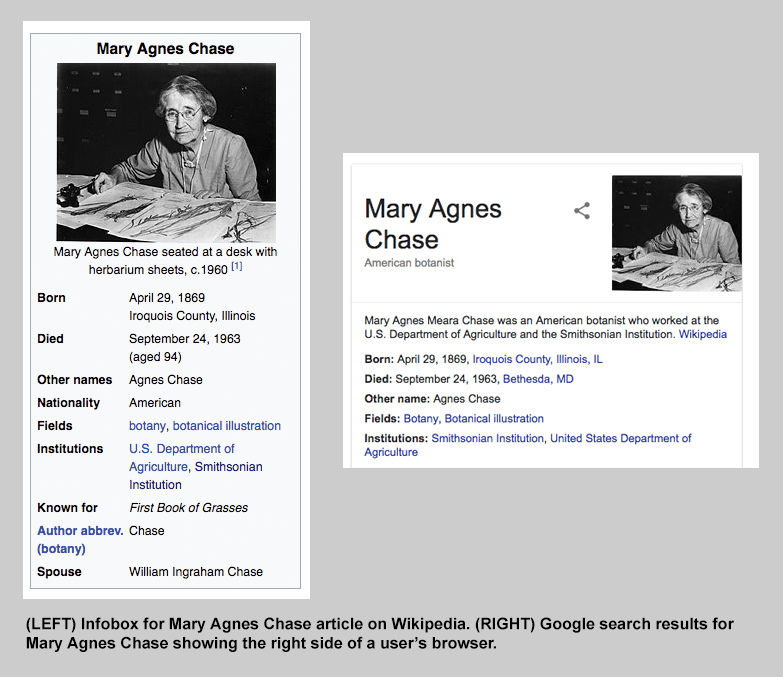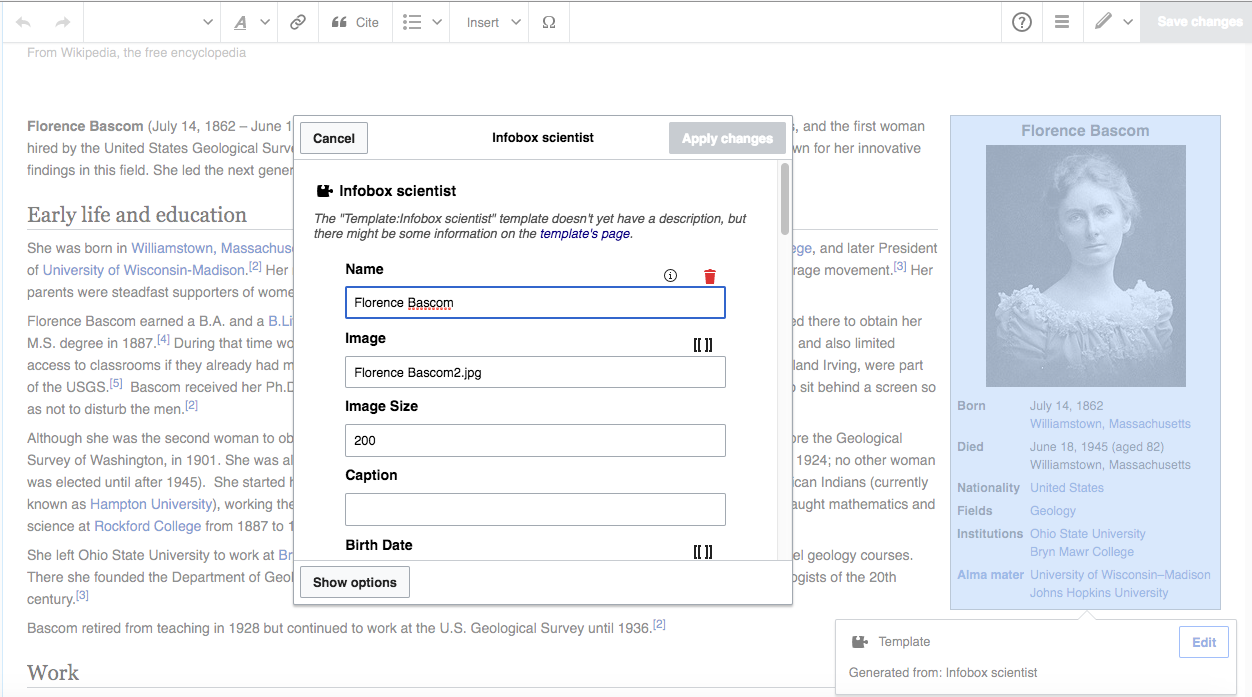We're ready to take our women in science to the next level! I hope botanist Mary Agnes Chase would be proud.
This journey started with our history of science and the media research fellow, Marcel LaFollette, who created basic records for female scientists she uncovered in the Archives' Science Service collection, including many who worked at the Smithsonian. We then created a campaign to amplify the records, and create a secondary source for Wikipedia with our "Women in Science Wednesday" campaign. Then we held several Wikipedia edit-a-thons with our local Wikimedia DC chapter to turn those resources into articles. Tomorrow we are kicking off a mini-campaign to take the hard work that wikipedia volunteers have done and turn it into better structured data for Wikidata!
About Wikidata
Wikidata is a central repository for the structured data of its Wikimedia sister projects including Wikipedia, Wikivoyage, Wikisource, and others. Wikidata contains items ("all the things in human knowledge, including topics, concepts, and objects"), properties ("A property describes the data value of a statement and can be thought of as a category of data, for example 'color'..."), and values (the value for the the color of the sky is blue.) When put together, they make statements. According to Wikipedia, "a statement is how the information we know about an item—the data we have about it—gets recorded in Wikidata. This happens by pairing a property with at least one value; this pair is at the heart of a statement." For example:
Mary Agnes Chase (Item ID=Q3822242) was employed by (Property ID=P108) the Smithsonian (Item ID=Q131626).
Items have a unique identifier, or Q value, and Properties have a P value. The unique identifiers allow us to know if we are talking about the "same thing."
Finally "...content of Wikidata is available under a free license, exported using standard formats, and can be interlinked to other open data sets on the linked data web" (more about Wikidata here). So organizations, businesses and individuals can reuse this data and do mash-ups with their own data sets, as they see fit.
Wikidata & Cultural Heritage
So why does this matter to those of us in the cultural heritage world? We spend a lot of time researching, verifying, and writing data, or metadata, about our collections which has become a trusted source for researchers, educators, and the public alike. We want this data to be used and it talks about things we care about as humans; history, cultures, art, and science.
The Wikidata project started in 2012, so it is still pretty new. Wikidata volunteers take Wikipedia articles and glean structured data from them. The Wikidata unique IDs connect with other recognized authority files such as VIAF, WorldCat, LCCN (Library of Congress), ISNI, etc. that we recognize in the cultural heritage world, as well as other authority files used in the news and higher education sectors. So, this is pretty familiar territory for the cultural heritage sector, and we stand to be able to be able to enhance our data with some of the data other trusted sources are contributing to Wikidata. Plus, Wikidata gets around:

How You Can Help
Wikipedia volunteers have created great articles about female scientists found in the American history, but the Infoboxes, which can end up in Wikidata, are still messy, incomplete, or non-existent. We know that it takes a lot of time to attend Wikipedia edit-a-thons, and it may not be possible for you to do one in person if you don't live near a local chapter. So we're trying out smaller requests for help via social media and this blog to see if we can spruce up the structured data for these groundbreakers.
Tomorrow through Friday (July 19-21) join us for #WikiLunch and #WikiCommute and help us improve the infoboxes of female scientist! Our to-do list is below and we will focus on a different aspect of the infoboxes each time. Join us and have fun learn about these groundbreaking women:
- First, register for a Wikipedia account so you can participate.
- Next, sign up for the event so we can track what happens! The passcode is wikilunch.
- Choose the name of a woman below.
- Edit the infobox of the article (see below)
- Save what you did!

Infobox needs Known For information:
- https://en.wikipedia.org/wiki/Florence_Bascom
- https://en.wikipedia.org/wiki/Annie_Montague_Alexander
- https://en.wikipedia.org/wiki/Florence_Bascom
- https://en.wikipedia.org/wiki/Elzada_Clover
- https://en.wikipedia.org/wiki/Doris_Mable_Cochran
- https://en.wikipedia.org/wiki/Rose_E._Collom
- https://en.wikipedia.org/wiki/Margaret_D._Foster
- https://en.wikipedia.org/wiki/Dorothy_Garrod
- https://en.wikipedia.org/wiki/Libbie_Hyman
- https://en.wikipedia.org/wiki/Devra_G._Kleiman
- https://en.wikipedia.org/wiki/Roxie_Collie_Laybourne
- https://en.wikipedia.org/wiki/Ursula_B._Marvin
Infobox needs Education/Alma mater information:
- https://en.wikipedia.org/wiki/Florence_Bascom
- https://en.wikipedia.org/wiki/Doris_Holmes_Blake
- https://en.wikipedia.org/wiki/Janine_Brown
- https://en.wikipedia.org/wiki/Kari_Bruwelheide
- https://en.wikipedia.org/wiki/Mary_Van_Rensselaer_Buell
- https://en.wikipedia.org/wiki/Elzada_Clover (missing graduate school)
- https://en.wikipedia.org/wiki/Mireya_Correa
- https://en.wikipedia.org/wiki/Edna_H._Fawcett
- https://en.wikipedia.org/wiki/Margaret_D._Foster
- https://en.wikipedia.org/wiki/Dorothy_Garrod
- https://en.wikipedia.org/wiki/Devra_G._Kleiman
- https://en.wikipedia.org/wiki/Roxie_Collie_Laybourne
- https://en.wikipedia.org/wiki/Ursula_B._Marvin
- https://en.wikipedia.org/wiki/Mary_J._Rathbun
Infobox needs Workplaces information:
- https://en.wikipedia.org/wiki/Florence_Bascom
- https://en.wikipedia.org/wiki/Doris_Holmes_Blake
- https://en.wikipedia.org/wiki/Emma_Lucy_Braun
- https://en.wikipedia.org/wiki/Nellie_A._Brown
- https://en.wikipedia.org/wiki/Mary_Van_Rensselaer_Buell
- https://en.wikipedia.org/wiki/Mary_Agnes_Chase
- https://en.wikipedia.org/wiki/Elzada_Clover
- https://en.wikipedia.org/wiki/Doris_Mable_Cochran
- https://en.wikipedia.org/wiki/Mireya_Correa
- https://en.wikipedia.org/wiki/Wanda_Kirkbride_Farr
- https://en.wikipedia.org/wiki/Edna_H._Fawcett
- https://en.wikipedia.org/wiki/Margaret_D._Foster
- https://en.wikipedia.org/wiki/Vicki_Funk
- https://en.wikipedia.org/wiki/Dorothy_Garrod
- https://en.wikipedia.org/wiki/Libbie_Hyman
- https://en.wikipedia.org/wiki/Devra_G._Kleiman
- https://en.wikipedia.org/wiki/Ursula_B._Marvin
- https://en.wikipedia.org/wiki/Mary_J._Rathbun
Infobox needs Identifiers/Authority control information:
- https://en.wikipedia.org/wiki/Kari_Bruwelheide
- https://en.wikipedia.org/wiki/Mary_Van_Rensselaer_Buell
- https://en.wikipedia.org/wiki/Elzada_Clover (only one listed)
- https://en.wikipedia.org/wiki/Wilmatte_Porter_Cockerell
- https://en.wikipedia.org/wiki/Mireya_Correa (only 2 listed)
- https://en.wikipedia.org/wiki/Rose_E._Collom
- https://en.wikipedia.org/wiki/Edna_H._Fawcett
- https://en.wikipedia.org/wiki/Margaret_D._Foster
- https://en.wikipedia.org/wiki/Vicki_Funk
- https://en.wikipedia.org/wiki/JoGayle_Howard
- https://en.wikipedia.org/wiki/Libbie_Hyman
- https://en.wikipedia.org/wiki/Roxie_Collie_Laybourne
Infobox needs Awards information:
- https://en.wikipedia.org/wiki/Mary_Agnes_Chase
- https://en.wikipedia.org/wiki/Rose_E._Collom
- https://en.wikipedia.org/wiki/Ursula_B._Marvin
While not a scientist herself, this woman was a patron to many scientists, so needs Patron information:
Related Resources
Produced by the Smithsonian Institution Archives. For copyright questions, please see the Terms of Use.



Leave a Comment